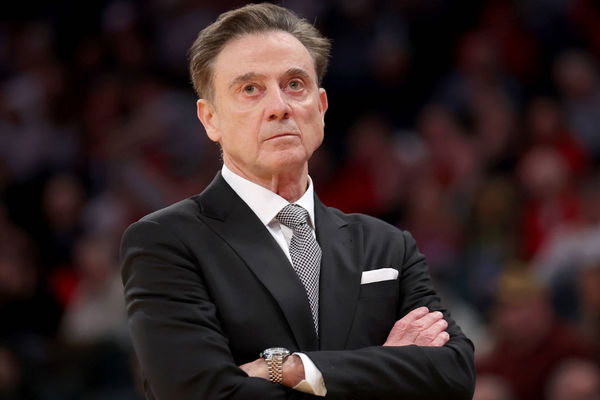
via Imago
NCAA, College League, USA Basketball: Big East Conference Tournament Semifinal – St. Johns vs Marquette Mar 14, 2025 New York, NY, USA St. John s Red Storm head coach Rick Pitino coaches against the Marquette Golden Eagles during the first half at Madison Square Garden. New York Madison Square Garden NY USA, EDITORIAL USE ONLY PUBLICATIONxINxGERxSUIxAUTxONLY Copyright: xBradxPennerx 20250314_bjp_ae5_012

via Imago
NCAA, College League, USA Basketball: Big East Conference Tournament Semifinal – St. Johns vs Marquette Mar 14, 2025 New York, NY, USA St. John s Red Storm head coach Rick Pitino coaches against the Marquette Golden Eagles during the first half at Madison Square Garden. New York Madison Square Garden NY USA, EDITORIAL USE ONLY PUBLICATIONxINxGERxSUIxAUTxONLY Copyright: xBradxPennerx 20250314_bjp_ae5_012
Rick Pitino has been a controversial figure in college basketball for decades. As his Hall-of-Fame-level coaching career has often been clouded by the numerous scandals he has been linked with. Between winning national championships, Pitino was either accused of allegedly participating in bribery and illegal benefits to multiple recruits. Overcoming this and returning to the top of college basketball hasn’t been an issue for him. Now, more details have surfaced about his $10 million NCAA privilege, which has reignited the conversation about financial inequality in college sports.
The contrast is almost surreal. While programs like Villanova and St. John’s are able to spend millions on basketball programs. SEC programs don’t have the same luxury because of they have to concentrate their spending on their football-first priorities. “It’s a problem,” the athletic director of one SEC school conceded, “Villanova and St. John’s can pour $10 million into basketball if they want. The SEC isn’t going to be able to do that because we cannot sacrifice the cash cow of football.”
This irony is particularly sharp given that power conferences were the ones who crafted stringent booster regulations in the past. And now they find themselves unable to compete with the free spenders they tried to hold accountable.
ADVERTISEMENT
Article continues below this ad
The free spenders who ruined college sports would like other schools to stop their free spending https://t.co/I0jX6fJmyq
— The UConn Blog (@TheUConnBlog) March 26, 2025
Now, NCAA has rolled out new regulations that are likely to shake things up even more. A recent settlement has put a cap on athlete compensation at $20.5 million annually, with penalties for exceeding this amount. This could hit SEC schools hard, especially since they’re already stretched thin by their football commitments.
Interestingly, schools like St. John’s, which focus mainly on basketball, may not feel the sting as much. It’s a situation where the SEC’s own rules might actually put them at a disadvantage when it comes to competing with schools like St. John’s.
Rick Pitino has weighed in on this issue, making it clear that St. John’s success isn’t just about spending big on NIL deals. Sure, they have one of the largest Nil budgets in the Big East. But Pitino points out that key players like Zuby Ejiofor and RJ Luis Jr. are actually “very low-paid”. So, despite the rumors, NIL money isn’t the main driver behind their success. Still, Pitino acknowledges that retaining talent like Ejiofor and Luis will require some financial effort, joking that the players will soon be knocking on the GM’s door asking for better deals after the season.
What’s your perspective on:
Is Rick Pitino's $10 million privilege a testament to his skill or a flaw in the system?
Have an interesting take?
Rick Pitino’s pivotal offseason
Looking ahead, Pitino is gearing up for a critical offseason. The Red Storm are set to lose key graduate transfers like Aaron Scott, Kadary Richmond, and Deivon Smith, leaving three spots to fill. Pitino’s wish list? A sharpshooting wing and a rim-protecting center—players who command top-tier NIL money. And if he wants to keep players like RJ Luis and Zuby Ejiofor, their deals will need to be sweetened. Pitino has left that job to GM Matt Abdelmassih, knowing full well that the financial side of college basketball is just as important as the Xs and Os.
ADVERTISEMENT
Article continues below this ad

via Imago
NCAA, College League, USA Basketball: NCAA Tournament First Round Practice Mar 19, 2025 Providence, RI, USA St. John s Red Storm head coach Rick Pitino speaks to the media during a press conference, PK, Pressekonferenz at Amica Mutual Pavilion. Providence Amica Mutual Pavilion RI USA, EDITORIAL USE ONLY PUBLICATIONxINxGERxSUIxAUTxONLY Copyright: xEricxCanhax 20250319_jla_qe2_446
There’s another layer to this: The threat of poaching. With competing programs such as Arkansas handing out six-figure NIL packages even to reserves. St. John’s will have a decision to make: pony up or let Pitino outmaneuver competition. Given Pitino’s history, it’s not crazy to believe he could do so again. His 2024-25 team already overachieved relative to their budget, suggesting that great coaching can sometimes overcome a financial gap.
However, if Pitino wants to take the Red Storm from being strong contenders to actual champions, he’ll need more than just coaching brilliance—he’ll need a financial boost to match his ambitions.
ADVERTISEMENT
Article continues below this ad
The debate over financial inequality in college basketball is far from over. As the NCAA introduces new rules and schools like St. John’s find themselves in a unique position, the question remains: Can coaches like Rick Pitino continue to succeed in an era of financial disparity, or will they be left behind? Only time will tell, but for now, Pitino’s $10 million NCAA privilege is sure to keep the conversation going.
ADVERTISEMENT
ADVERTISEMENT
ADVERTISEMENT
ADVERTISEMENT


Is Rick Pitino's $10 million privilege a testament to his skill or a flaw in the system?